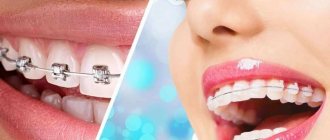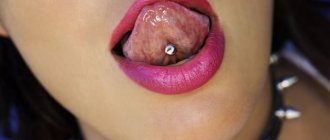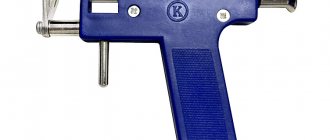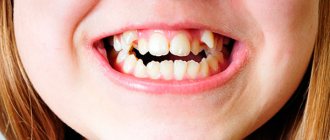Swallowing is a complex set of motor reactions that move food from the mouth through the esophagus to the stomach. The swallowing reflex is innate. It is important to note that during the correct act of swallowing, the tip of the tongue should normally rest against the anterior third of the hard palate.
A child is born with a well-developed swallowing mechanism, which in the first months is called infantile . Due to the contraction of the muscles of the lips, cheeks, and tongue during sucking, negative pressure is created in the baby’s mouth and milk enters the mouth, and the tongue, located between the toothless gums, directs the milk into the oropharynx. Before the first teeth erupt, this infantile type of swallowing , in which the tongue rests on the lips, is a physiological norm . But as baby teeth erupt, sucking is replaced by chewing, and the child’s type of swallowing changes to somatic . During somatic swallowing, the tongue is located in the anterior third of the hard palate, while the back of the tongue pushes food into the larynx.
If a child constantly consumes liquid or semi-liquid food, despite the presence of teeth, then a full act of chewing is not formed, and the transition from the infantile type of swallowing to the somatic one does not occur. At the moment of swallowing, a child with an infantile type of swallowing places his tongue between the upper and lower rows of teeth, which contributes to the formation of an open bite. In this case, the perioral muscles are involved in the act of swallowing, i.e. the lower part of the orbicularis oris muscle, the mentalis muscle and the neck muscles noticeably tense, which is easy to detect by asking the child to swallow saliva.
An incorrect type of swallowing can also result from:
- Using a long pacifier that occupies the entire mouth of the infant and touches the soft palate, which interferes with the proper function of the tongue, soft palate and pharynx.
— Disturbances also occur when there is a large hole in the nipple, through which milk and milk formulas enter the oral cavity in large quantities, the child choke on the incoming food and can swallow it only after the nipple is removed from the mouth and the food flows out through the corners of the mouth. In this case, the forward position of the tongue, which regulates the flow of milk, can become fixed and cause improper swallowing.
— Chronic tonsillitis and adenoid growths also contribute to the tongue moving forward.
- If a child constantly consumes liquid or semi-liquid food, despite the presence of teeth, then a full-fledged act of chewing is not formed, and the transition from the infantile type of swallowing to the somatic one does not occur.
With the infantile type of swallowing, the child’s tongue gets used to only the simplest movements, so the lingual muscle develops poorly (the tongue is not sufficiently developed and mobile).
Does poor swallowing need to be corrected?
Certainly! Incorrect position of the tongue creates an unfavorable orthodontic situation in the mouth: distal bite, anterior and lateral open bites, underdevelopment of the upper jaw and advanced development of the lower jaw, narrowing of the hard palate, since the tongue ceases to perform a supporting function. Let me make a reservation that the main cause of malocclusion may not necessarily be the tongue. There are also hereditary factors! But, if the orthodontist is faced with an infantile type of swallowing, then it is advisable to send such a patient to a speech therapist to check the working parameters of the tongue. Why is this necessary if the wrong position has become habitual? The fact is that the tongue, as a powerful muscular organ, can “ruin” the work of the orthodontist. This won't happen right away. 1-2, perhaps 3 years will pass, and the new bite created with such great efforts will begin to “creep”. And the reason may be improper functioning of the tongue. The specialists of the orthodontic department of the Family Dentistry have long worked in close cooperation with a speech therapist and receive stable treatment results.
If swallowing is improper, the chewing process also suffers. The patient may experience pain in the TMJ, cervical spine, occipital, temporal and frontal areas of the head.
Swallowing disorder
What is the difference between infantile and somatic swallowing?
With the infantile (children's) type of swallowing, the tongue is located in the form of a groove through which breast milk, and later other liquid food, simply flows into the pharynx and further into the stomach. Until the child has baby teeth, this is considered normal.
With the somatic type of swallowing, which is observed in children over 2 years of age, the tip of the tongue rests on the hard palate at the front teeth, and its back helps push the bolus of food into the pharynx.
The development of swallowing disorders is influenced by many factors:
- artificial feeding;
- bad habits - thumb or toy sucking;
- long-term use of a pacifier;
- shortened frenulum of the tongue;
- the predominance of semi-liquid dishes on the menu;
- mouth breathing.
With the infantile type, during swallowing, the muscles located around the mouth, on the chin and neck tense, and the tongue itself makes only minimal and simple movements. At the same time, he is forced to remain for a long time at the bottom of the oral cavity or between the teeth, which in turn leads to orthodontic and speech therapy problems.
Consequences of infantile swallowing
Due to the pressure of the tongue on the front teeth (a person swallows more than 650 times a day), they gradually lean forward. And the constant position of the tongue between them forms an open bite. It can be corrected with the help of orthodontic structures, but if the position of the tongue is not normalized, a relapse will occur, that is, the teeth will again take their previous incorrect position.
With atypical swallowing, external muscle pressure prevails over internal pressure. The most powerful effect is exerted by tightly compressed lips. As a result, the dentition becomes deformed and an incorrect bite is formed.
At the same time, the child develops articulation disorders and incorrect sound pronunciation, mainly problems with the pronunciation of whistling sounds - interdental sigmatism.
In addition, the result of improper swallowing can be:
- disproportionate development of the upper and lower jaws;
- narrowing of the hard palate;
- weakness of the lingual muscle, which some experts mistakenly mistake for macroglossia.
Swallowing disorders are aggravated by the presence of oral or mixed breathing. Thus, myofunctional disorders develop, leading to serious orthodontic problems. Therefore, a dentist who discovers muscle dysfunction must refer the patient to a speech therapist. Its help in correcting improper swallowing is a combination of massage effects on the tongue and articulation exercises for the muscles of the tongue, lips, cheeks, soft palate and neck. Only together are these two specialists able to cope with the pathology and prevent relapse.
How to correct infantile type of swallowing?
A new way of swallowing, also called somatic, will be created by a speech therapist who will prescribe a special set of articulatory gymnastics and training exercises. The complex is selected individually, but there are also exercises common to all (see the list below).
Exercises can and should be done before, during and after orthodontic treatment. It is best to start before installing orthodontic appliances. If the case is simple, then the exercises are performed for 10-15 minutes daily for 1.5-2 months. During scheduled classes, the speech therapist corrects the technique of performing exercises, introduces additional exercises into the complex to consolidate the necessary skills, and massages the tongue.
Dysphagia in the elderly
Biyarslanova Raisa Mavladinovna Therapist,
More about the doctor
Dysphagia , or the inability to swallow anything, is a symptom of a number of diseases and is diagnosed in more than 12% of elderly and senile people. This pathological symptom develops against the background of some chronic diseases of the gastrointestinal tract, central and peripheral nervous system. Treatment after an accurate diagnosis can be either constructive or include surgical intervention. In most cases, the prognosis is moderately positive.
Pathogenesis and causes of dysphagia
The reasons that make it difficult for a bolus of food to pass through the pharynx through the esophagus into the stomach are divided into several types. If dysphagia of the pharynx is observed, they speak of oropharyngeal disorders, if of the esophagus - gastroesophageal disorders. Depending on the etiology there are:
- causes of mechanical compression of the esophagus or pharynx - rapid growth of benign or malignant tumors, some forms of tonsillitis, diphtheria, immediate allergic reactions (anaphylactic shock, Quincke's edema), pathologies of the thyroid gland, destructive diseases of the musculoskeletal system (cervical and thoracic spine), blockage of the pharynx or esophagus by any foreign object, etc.;
- disruption of the innervation of the pharynx and/or esophagus - cerebral stroke, and Alzheimer's disease , other neurodegenerative diseases.
The development of dysphagia in the elderly can follow both obstructive and dysregulatory paths. Sometimes a combination of these two branches of pathogenesis is observed. Swallowing disorders caused by mechanical compression of the esophagus or pharynx, or a foreign body entering the lumen, often require surgical intervention. Disturbances in the regulation of smooth muscle tone, which is responsible for the process of moving food from the pharynx to the stomach, require conservative treatment. In any case, therapy aimed at eliminating symptoms is not effective without addressing the root cause - the disease that provoked the occurrence of dysphagia.
Symptoms of dysphagia in the elderly
If a patient consults a doctor with complaints of difficulty swallowing solid food, discomfort that occurs while eating, the specialist will diagnose the 1st (initial) phase of dysphagia. Without adequate therapy, the patient's condition worsens, swallowing liquid becomes difficult, and dysphagia progresses to stage 2. At stage 3, the ability to swallow saliva is lost. Stage 4 is characterized by a complete absence of the swallowing reflex and the ability to swallow anything.
Associated symptoms include a sore throat, inflammation in the pharynx or esophagus, a dry persistent cough without an increase in overall body temperature, and hoarseness. A dull, moderately intense pain may appear.
Diagnosis and treatment of dysphagia
The diagnosis is made and clarified using the following instrumental methods of analysis: pharyngoscopy, x-ray of the esophagus, esophagogastroscopy, pH-metry (daily). To assess the state of the central nervous system, computed tomography or MRI is performed.
The treatment regimen for swallowing disorders without surgical intervention includes taking calcium channel blockers (to relieve spasms), nitrates (have a relaxing effect), and antisecretory agents. For diseases of the central nervous system, as well as during the period of rehabilitation after strokes, neuroprotectors and drugs that improve cerebral circulation are prescribed.
If the cause of dysphagia is muscle dysfunction, special exercises are prescribed to make the muscles work correctly.
Regardless of the cause of the disease, patients need to adhere to the rules of proper nutrition and eat small portions. You can't eat it dry.
In some cases, dysphagia can only be eliminated surgically. If surgery is refused, the prognosis becomes strictly unfavorable with a high probability of death.
Causes
There are several reasons why a child may persist in the wrong type of swallowing:
- Lack of solid food in the diet after the eruption of baby teeth. If a child with the appearance of a temporary bite continues to consume only liquid food, the chewing function does not become the main one and infantile swallowing is not replaced by somatic swallowing.
- Mouth breathing (with chronic rhinitis, tonsillitis, and adenoids) contributes to the anterior position of the tongue and disruption of the transition to the somatic type of swallowing.
- Shortening of the frenulum of the tongue.
- Using the wrong pacifier (too long or with a large hole).
- Use of a pacifier for more than 1 year after the birth of the child. Up to 10-11 months, sucking is the main function for the baby, however, with the eruption of primary teeth, this function fades away, and chewing becomes the main function. If parents continue to use a pacifier for more than one year, this can lead to a disruption in the change from the infantile type to the somatic type of swallowing.
- Violation of the timing of the eruption of primary teeth (later than 3 months from the physiological norm).
Treatment
To normalize swallowing function, a set of measures is recommended:
- Elimination of all possible causes that could lead to the persistence of the infantile type of swallowing (restoration of nasal breathing, adding solid food to the diet, etc.).
- Myogymnastics are special exercises for the muscles of the maxillofacial area, helping to normalize the function of swallowing.
- Use of orthodontic appliances with a tongue rest (for example, MUPPY plates).
We advise you to read: Myogymnastics as a method of orthodontic treatment











